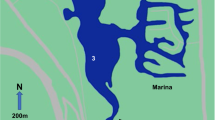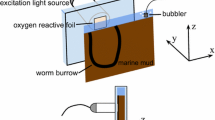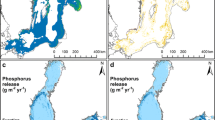Abstract
Deep-burrowing crustaceans are common on all coasts. In a series of model experiments conducted at the Hawaii Institute of Marine Biology from March to October 1977, the effect of the alpheid shrimp Alpheus mackayi Banner and Banner, on material fluxes across the sediment-water interface has been determined. Viewed as a “biological pump”, the shrimp's irrigation pattern was not random, but intermittent, with a mean period of 6 min activity and 16 min resting. Plume velocities between 1 and 18 cm s−1 were measured by seawater-resistant hot-wire anernometry at the apertures of active burrows. Based on 55 h of velocity data, mean hourly pumping rates of 0.35 liters h−1 were calculated, with an average mechanical energy of 4000 erg h−1 dissipated by burrow-wall friction and plume mixing. In microcosm experiments with 177 cm2 sediment surface area and 120 cm2 burrow-system surface, the pumping of one shrimp enhanced the release of silica from the pore water by an average factor of 5 compared to concentration gradient-driven flux across the sedimentwater interface in a control core with the same dimensions but without a shrimp. Our data suggest that “real-world models” of interfacial fluxes without inclusion of the macro-infauna as biological pumps will be unrealistic.
Similar content being viewed by others
Literature cited
Aller, R. C. and J. Y. Yingst: Biogeochemistry of tube-dwellings: a study of the sedentary polychaete Amphitrite ornata (Leidy). J. mar. Res. 36, 201–254 (1978)
Brennen, Ch. and H. Winet: Fluid mechanics of propulsion by cilia and flagella. A. Rev. Fluid Mech. 9, 339–398 (1977)
Florek, R.: Measurements of the production and diffusion of sediment pore water ammonia, unpublished manuscript (prepared under Woods Hole Oceanographic Institution Summer Fellowship) 1977
Foster-Smith, R. L. and R. O. Shillaker: Tube irrigation by Lembos websteri Bate and Corophium bonnelli Milne Edwards (Crustacea: Amphipoda). J. exp. mar. Biol. Ecol. 26, 289–296 (1977)
Grant, J.: A flume study of drift in marine infaunal amphipods (Haustoriidae). Mar. Biol. 56, 79–84 (1980)
Gust, G.: Observations on turbulent drag reduction in a dilute suspension of clay in sea-water. J. Fluid Mech. 76, 29–47 (1976)
Gust, G.: Turbulence and waves inside flexible-wall systems designed for biological studies. Mar. Biol. 42, 47–53 (1977)
Gust, G.: Tools for oceanic small scale, high frequency flows: metal-clad hot wires. J. geophys. Res. (In press). (1981)
Hoffman, R. J. and C. P. Mangum: Passive ventilation in benthic annelids? Science, N. Y. 176, p. 1356 (1972)
Hurd, D. C.: Interactions of biogenic opal, sediment and seawater in the Central Equatorial Pacific. Geochim. cosmochim. Acta 37, 2257–2282 (1973)
Ling, S. C. and T. Y. J. Ling: Anomalous drag-reducing phenomenon at a water/fish-mucus or polymer interface. J. Fluid Mech. 65, 499–512 (1974)
Lock, M. A. and P. H. John: The effect of flow pattern on uptake of phosphorus by river periphyton. Limnol. Oceanogr. 24, 376–383 (1979)
McCaffrey, R. J., A. C. Myers, E. Davey, G. Morrison, M. Bender, N. Luedtke, D. Cullen, Ph. Froelich and G. Klinkhammer: The relationship between pore water chemistry and benthic fluxes of nutrients and manganese in Narrangansett Bay, RJ. Limnol. Oceanogr. 25, 31–44 (1980)
Moody, L. F.: Friction factors for pipe flow. Trans. Am. Soc. mech. Engrs 66, 671–684 (1944)
Morse, J. W.: Calculation of diffusive fluxes across the sediment-water interface. J. geophys. Res. 79, 5045–5048 (1974)
Nachtigall, W.: Swimming mechanics and energetics of locomoion of variously sized water beetles-Dytiscidae, body length 2 to 35 mm. In: Scale effects in animal locomotion, pp 269–283. Ed. by T. J. Pedley, New York: Academic Press 1977
Nixon, S. W., C. A. Oviatt and B. A. Buckley: Turbulent mixing in marine microcosms-some relative measures and ecological consequences. In: Advances in marine environmental research, pp 382–409. Ed. by F. S. Jacoff. Narragansett, R. I.: Environmental Protection Agency 1979
Ott, J. A., B. Fuchs, R. Fuchs and A. Malasek: Observations on the biology of Callianassa stebbingi Borrodaille and Upogebia litoralis Risso and their effect upon the sediment. Senckenberg, marit. 8, 61–79 (1976)
Rhoads, D. C.: Organism-sediment relations on the muddy sea floor. Oceanogr. mar. Biol. A. Rev. 12, 263–300 (1974)
Rhoads, D. C., J. Y. Yingst and W. J. Ullman: Seafloor stability in Central Long Island Sound. Part I. Temporal changes in erodibility of fine-grained sediment. In: Estuarine interaction, pp 221–244. Ed. by M. L. Wiley, New York: Academic Press 1978
Rowe, G. T., C. H. Clifford and K. L. Smith: Nutrient regeneration in sediments off Cap Blanc, Spanish Sahara. Deep-Sea Res. 24, 57–63 (1977)
Schink, D. R. and N. L. Guinasso, Jr.: Effects of bioturbation on sediment-seawater interaction. Mar. Geol. 23, 133–154 (1977)
Thistle, D.: A taxonomic comparison of the American Upogebia (Decapoda, Thalassinidea), including two new species from the Caribbean. Breviora. 408 (Sept. 20) 1–23 (1973)
Torres, J. J., D. L. Gluck and J. J. Childress: Activity and physiological significance of the pleopods in the respiration of Callianassa californiensis (Dana) (Crustacea: Thalassinidea). Biol. Bull. mar. biol. Bull., Woods Hole 152, 134–146 (1977)
Trevor, J. H.: The dynamics and mechanical energy expenditure of the polychaetes Nephtys cirrosa, Nereis diversicolor and Arenicola marina during burrowing. Estuar. cstl mar. Sci. 6, 605–619 (1978)
Vanderborght, J. P. and R. Wollast: Mass transfer properties in sediments near the benthic boundary layer. In: Bottom turbulence, pp 209–219. Ed. by J. C. J. Nihoul. Amsterdam: Elsevier 1977
Vogel, S.: Reply to Hoffman, R. T. and C. P. Mangum. Passive ventilation in benthic annelids? Science, N.Y. 176, 1356–1357 (1972)
Vogel, S. and W. L. Breyz: Interfacial organisms: passive ventilation in the velocity gradients near surfaces. Science, N.Y. 175, 210–211 (1972)
Waterman, T. H. (Ed.): The physiology of Crustacea, Vol. 1. Metabolism and growth, 670 pp. New York: Academic Press 1960
Author information
Authors and Affiliations
Additional information
Communicated by J. M. Lawrence, Tampa
Rights and permissions
About this article
Cite this article
Gust, G., Harrison, J.T. Biological pumps at the sediment-water interface: Mechanistic evaluation of the alpheid shrimp Alpheus mackayi and its irrigation pattern. Marine Biology 64, 71–78 (1981). https://doi.org/10.1007/BF00394082
Accepted:
Issue Date:
DOI: https://doi.org/10.1007/BF00394082




